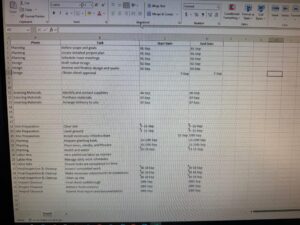
The importance of scheduling
By Patrick Regnault
From quoting to completion, having a well-planned work schedule improves efficiency and reduces cost and wastage. Time spent on working out the method and timing of each phase of the work will ensure the quotation is accurate, the project will run smoothly, the client will feel confident everything is under control, and the materials will be of sufficient quality and quantity.
Scheduling for quotation
To quote effectively it is worth spending the time on understanding the site and preparing a work and material schedule for each stage. We may not always win the job but working out the schedule is not wasted as the more we familiarise ourselves with the task the easier and faster it becomes.
When breaking up the work into individual tasks it is useful to know what is required in terms of workforce, tools and materials. It helps to predict which tasks can be best done at the same time, and avoid duplicating and wasting time. For a quote it means you may be able to maximise your margin whilst producing a competitive quote.
Scheduling for materials
Material costs are a large component of any job. It is not just the cost of the materials itself but their storage and movement within the site. A well-run site will have the material onsite when needed and as close to the quantity required for the desired task to avoid getting in the way or having to be moved twice. It also helps to reduce waste, costing less to the business and the environment.
Scheduling for transport
Deliveries are expensive and if we can plan correctly, we can reduce the cost by ordering larger quantities and planning the workforce needed to move the material. However, and this is important, sometimes it is more effective to have two separate deliveries to avoid unnecessary pressure being piled upon the workers. After all, managing employees is part of scheduling as well.
Plant schedule
Scheduling plant materials involves planning and forethought. Having a plant schedule enables you to source materials in advance. Of course, quality and quantities come into consideration as well as the type of plants suited to the site and how they will be in 10 or 20 years.
If we are the one designing and planting, we need to be very careful with our plant selection, by choosing plants we understand will do well without being boring. If we are following someone else’s plant selection, we need to be honest and if we think some plants are not suitable, we need to make it clear and even refuse to plant them. As a knowledgeable contractor this is our obligation and duty. Not doing so could have legal ramifications in the long term.
Trees need to be well selected for their form, species and durability, but also, their height, root system and disease resistance. We have all seen trees planted too close to a house that needed to be removed after ten years, or invasive root systems causing drainage or structural problems, sometimes significantly so.
Scheduling chaos
It may seem a contradiction in terms; how can one incorporate the unknown in a schedule? We all know that it is very rare that everything happens as planned. It could be weather related, a staff shortage due to illness, a delivery truck breaking down, you name it something is likely to happen. Regardless of how well run a worksite is, delays need to be part of the schedule. 10 to 20% of the time allocated should be set aside for unplanned changes, this means having to be flexible and plan how the work can be run efficiently without affecting the smoothness of the site. Can we do another task whilst waiting for the delivery? Can we prepare or build something offsite or undercover whilst it rains? Do we have a small job we can fit in if the delay runs into days and not hours? If this turns out to be the case we need to communicate the changes sensibly to the client, other trades, and the team. Doing this will make us look professional and avoid later conflicts.
Scheduling payment
The deposit, progress payments, variations and final handover should be very clearly recorded and signed by all parties. This would require an entire article by another person who is very knowledgeable.
Patrick Regnault FAIH RH0062
Interactive Landscapes
E: patrickregnault@hotmail.com
